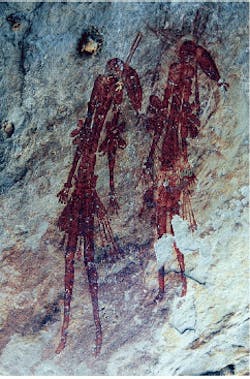OPTICALLY STIMULATED LUMINESCENCE: Laser technique dates Ice-Age paintings
Grains of sand from age-hardened mud-wasp nests and laser-based optically stimulated luminescence (OSL) have enabled Australian scientists to establish that rock paintings in the Kimberley region of Western Australia are at least 17,000 years old—which puts the paintings among the world’s oldest.
A team led by geochronologist Dr. Bert Roberts of the School of Earth Sciences at the La Trobe University in Melbourne conducted the dating experiment.1 The minimum age of the artwork was obtained by OSL, which dated quartz grains embedded in two wasp nests built directly over the artwork. The painting is of mulberry-colored human figures in the "Bradshaw" style, which overlies a large hand-stencil (see photo).
Optically stimulated luminescence exploits the fact that natural radiation in the soil—such as radioisotopes potassium-40, thorium-232 and uranium-238—excites electrons to move through the crystal lattice until they become trapped in imperfections in mineral crystals such as quartz. The process begins when the crystals, or grains, are covered by—in this case—mud as wasps build their nests. Only those trapped electrons that can be freed by absorption of visible photons through exposure to laser light are subsequently sampled, and the aim is to determine the radiation dose (paleodose) and, hence, time since the last exposure to light.
After carefully removing the quartz grains from the mud-wasp nests at night using red-filtered (>590 nm) light, Roberts exposed them to laser light to free the trapped electrons, which released their energy as light. The more light emitted, the greater the age.
A 514.5-nm beam from an argon-ion laser was passed through glass filters to remove unwanted light below 500 nm, then into the sample chamber where it was directed by optical fibers onto a few milligrams of sample. The scattered 514.5-nm beam was then attenuated by blue-pass glass filters in front of a photomultiplier tube because the team wished to sample only UV and blue photons emitted by the sample. Count rates ranged from a few hundred per second to over one million photon counts per second, compared to a background of around 50 counts/s.
Direct evidence
Until now, evidence of antiquity for Australian paintings was indirect. It consisted of fragments of ochre-covered sandstone (40,000 years) unearthed in the Kimberleys and stashes of ground pigments (51,000 to 61,000 years) found in the Kakadu region of the Northern Territory. The minimum of 17,000 years for the paintings—named the "Bradshaws" after the 19th-century explorer who first found them—places them within striking distance of the world’s oldest. But fixing the maximum age on what are now Australia`s first authenticated Ice-Age paintings will require finding another nest stump from beneath one of them. And it now appears that there are several painted nest stumps that will allow a maximum age to be determined.
Meanwhile, because mud-wasps are found worldwide, the team believes this technique could be used to study rock art and ancient environments anywhere. Indeed, sediment accretions created by some other animals, such as ants, termites, and mud-nesting birds, may also be suitable for optical dating if the mineral grains were fully exposed to sunlight during final emplacement.
REFERENCE
1. Bert Roberts et al., Nature 387, 696 (June 12, 1997).
